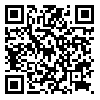BibTeX | RIS | EndNote | Medlars | ProCite | Reference Manager | RefWorks
Send citation to:
URL: http://jdisabilstud.org/article-1-2147-en.html
2- Professor, Department of Counseling, Arak Branch, Islamic Azad University, Arak, Iran; Department of Counseling, Kharazmi University, Tehran, Iran
3- Assistant Professor, Counseling Department, Khomein Branch, Islamic Azad University, Khomein, Iran
4- Assistant Professor, Department of Psychology, Arak Branch, Islamic Azad University, Arak, Iran
Abstract
Background & Objectives: Family caregivers are a vital support system for the sick because they take care of the patient emotionally and physically. With the increase in the number of children with chronic disorders, it is expected that the number of family caregivers and the rate of care complications rise. Family caregivers, especially mothers caring for their children who suffer from chronic illnesses, such as autism or physical disabilities, seem to be rising, which causes negative emotions such as anxiety in the long term. This issue is essential for the mental health of the mothers and society. The mothers' resort to emotional regulation strategies and maladaptive defenses such as emotional repression complicate and worsen their psychological state. This problem requires intervention and the application of psychotherapy approaches as effectively as possible. The present study aimed to compare the effectiveness of schema–based education and acceptance and commitment–based education on emotional repression in family–caring mothers.
Methods: The research method was quasi–experimental with a pretest–posttest and follow–up design with a control group. The statistical population of this study comprised all mothers with children with autism or physical disabilities studying in exceptional children's schools in Tehran City, Iran, in 2019. Of whom 45 eligible and volunteered mothers entered the study, and with the homogenization of age and duration of care, they were assigned to two experimental groups and one control group. The inclusion criteria were as follows: at least three years of care experience, a score higher than the cut–off point in the short version of the Young Schema Questionnaire or at least two schema areas and the second version of the Acceptance and Action Questionnaire–II, having chronic physical and mental illnesses, not abusing drugs and alcohol, not using medication and not receiving psychological treatments at the same time. The exclusion criteria included absence in one–third of the sessions, conflict with a crisis or specific illness, or removal of any conditions for entering the training during the sessions. Participants in three stages of pretest, posttest, and follow–up answered the Weinberger Adjustment Inventory–Short Form (Weinberger, 1990), Young Schema Questionnaire–Short Form (Young, 1998), and Acceptance and Action Questionnaire–II (Bond et al., 2011). In this study, descriptive statistics indicators (mean, standard deviation, frequency, and percentage) were used to describe the data, and statistical methods of analysis of variance and Chi–square, analysis of variance with repeated measurements, and Bonferroni post hoc test were used for data analysis through SPSS software. The significance level of statistical tests was 0.05.
Results: The findings showed significant effects of group, time, and the interaction of group and time on emotional suppression and its components including inhibition and defensiveness (p<0.05). Also, the results indicate a significant difference between schema–based education and acceptance and commitment–based education with each other (p=0.006) and with the control group (p=0.001) in the component of defensiveness. In addition, there is a significant difference between both types of education and the control group (p=0.001) in the total score of emotional suppression. In the experimental groups, there was a significant difference between the averages of the pretest with posttest and follow–up stages in the components of inhibition and defensiveness and the total score of emotional suppression (p=0.001). Both types of education for all three mentioned variables had a lasting effect over time (p=1.000).
Conclusion: Based on the findings of the present study, schema–based education and acceptance and commitment–based education on reducing emotional suppression and its components, including effective inhibition and defensiveness. However, acceptance and commitment education is more effective in reducing the defensiveness component.
| Rights and permissions | |
 |
This work is licensed under a Creative Commons Attribution-NonCommercial 4.0 International License. |



